


Zajedno do fondova EU
More about Vižula
A PENINSULA AT THE TIP OF THE MEDITERRANEAN

The latest archaeological research suggests that a monumental and luxurious imperial palace existed at Vižula in the 3rd and 4th centuries AD (at the time of the Emperor Constantine). We can say with certainty that this site, which has been inhabited since the Neolithic period, with its centuries-old architectural tradition from the age of Imperial Rome (the period from the 1st to the 5th century), represents one of the most beautiful residential villas on the eastern shore of the Adriatic.
The archaeologist Igor Miholjek has pointed out that the Roman villa at Vižula is located in a position that has been strategically important in a maritime sense in this part of the Adriatic ever since Antiquity. The Vižula peninsula lies in Medulin Bay at the tip of the Mediterranean on a prominent ancient sea route that stretched from the Gulf of Trieste to Cape Kamenjak, where it then split: in the direction of Tarsatica and the islands of Cres, Lošinj, Unije and Susak on the one hand, and towards Dalmatia and the south on the other. This position provided a secure area for the villa residents and a safe anchoring site sheltered from strong winds and the open sea for seafarers.
The traces of the Romans’ magnificent civilisation which can be found across the peninsula and in the sea were protected in 1970 as monuments of culture. The construction of ancient villas on the eastern coast of the Adriatic started with the Roman conquests in the 2nd century BC and reached its heyday in the 1st and 2nd centuries AD. This can be seen in the impressive archaeological remains of the Vižula villa, which is characterised by its ‘size, luxurious construction, and expensive architectural details and construction materials’.
Dr Vesna Girardi Jurkić has pointed out that the Vižula villa was mentioned by Bernardo Schiavuzzi in 1907 as the imperial villa of Crispus, the son of Constantine the Great. The intensive archaeological research which has been carried out over the last three decades (first under the direction of Dr Girardi Jurkić and afterwards Kristina Džin) in the north-western part of the peninsula confirms that the area was continuously inhabited from the 1st to the 6th century, when the complex was destroyed and then rebuilt and transformed. In addition to numerous artefacts from this period, coins found here confirm a long human presence on the peninsula. Most items date back to the second half of the 4th century, when the old villa was demolished and rebuilt in accordance with the taste of the period.
There were numerous imperial estates in Istria. The Vižula villa is one of the eminent imperial villas, like the one in Verige Cove on the Brijuni Islands or Loron in the vicinity of Novigrad. Diocletian’s Palace in Split had the same status. In terms of its architectural features, Vižula is a maritime villa located on a spacious estate that combines all the benefits and advantages of the countryside and coast. Such villas were built in attractive locations, especially ‘prominent positions on a peninsula or in suitable coves, and typically occupy the entire coastline, and even the sea in front of the estate.
A MONUMENTAL VILLA ON FOUR TERRACES
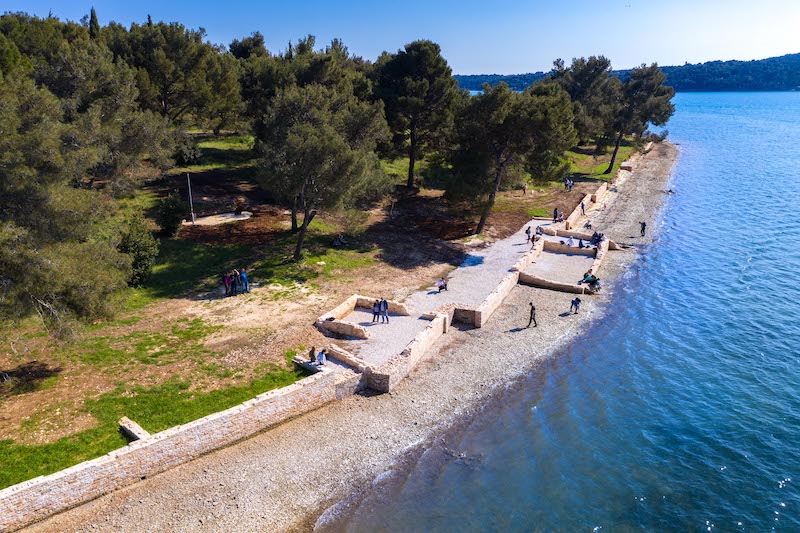
The Vižula villa, with its four cascading terraces that follow the slope of the terrain, its monumental façades facing the sea, and its porticoes, covered passages with columns, dominated the view of the coast with its size and distinctive architectural shape. The position of the Vižula villa, which in large part is today submerged due to natural forces such as the erosion of the soil and rises in the sea level, and its monumental size show all the characteristics of a maritime villa.
Vižula was home to dignitaries, patricians and senators. Their lifestyle involved comfort and enjoyment, and their wealth and luxury are reflected in all the parts of the villa discovered so far, such as its rich mosaics and colourful marble surfaces, its aqueduct, hypocaust (floor and wall heating systems for thermae with pools), audience and banqueting hall, peristyle with well-manicured gardens, and portico, which hosted all-night parties. In the vicinity of Vižula, a necropolis was discovered at the site of Burle. The wealth of artefacts that were found in the 312 tombs investigated include gold and emerald jewellery and the finest glass dishes. This additionally confirms the richness of the site and attests to the wealth of Vižula’s inhabitants. Some of these finds will be presented to the public.
In the Middle Ages and during Venetian rule, Vižula was an island separated from the coast of Medulin by a channel. At that time, it was called Isola di vescovo (Bishop’s Island).
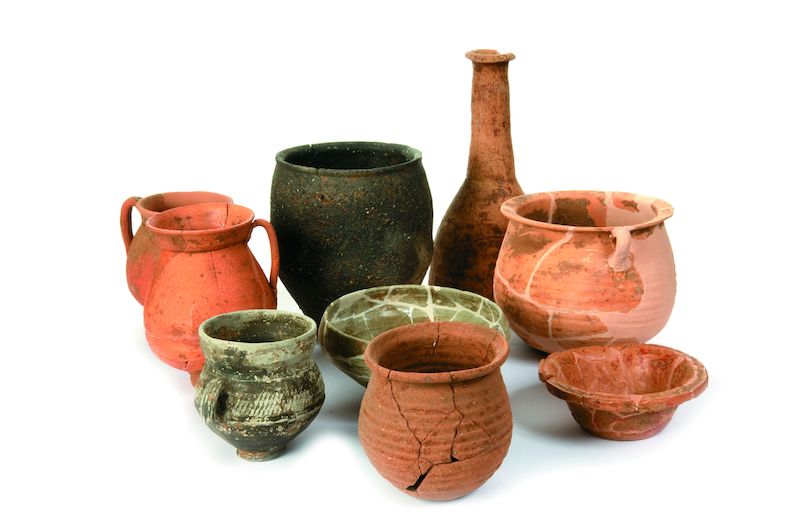
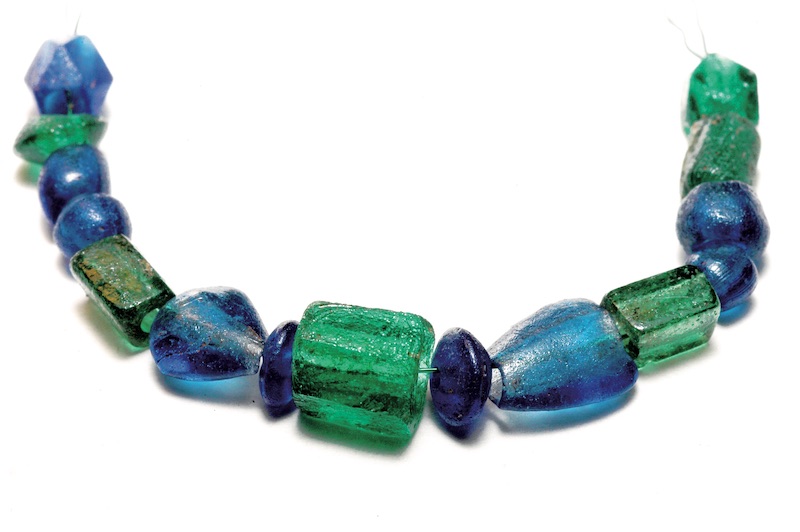
The numerous archaeological finds discovered at Vižula attest to the many centuries of luxurious lifestyle in this imperial villa or palace. Discovered items include drinking glasses, window glass, bronze hinges, iron nails, agricultural tools such as shovels, hammers and parts of a plough, pieces of fine table and rough household ceramics, decorative buckles and imperial Roman coins (e.g. Claudius, Augustus, Valentinian II), wine and oil amphorae, dolia for wheat, as well as tegulae – ceramic roof tiles marked with workshops stamps (Q. Clodius Ambrosius, Pansiana) for covering roofs and lining channels. A piece of a distinctive late antiquity drinking vessel decorated with the figure in relief of a prancing horse and a T-shaped crossbow bronze fibula from the 4th century are particularly interesting. Ceramic items imported from the Middle East, Greece, Egypt, Italy and Gaul were found in all parts of this luxury villa. They date back to the most luxurious period of life in the villa, from the 1st to the 6th century.
AN ANCIENT GARDEN
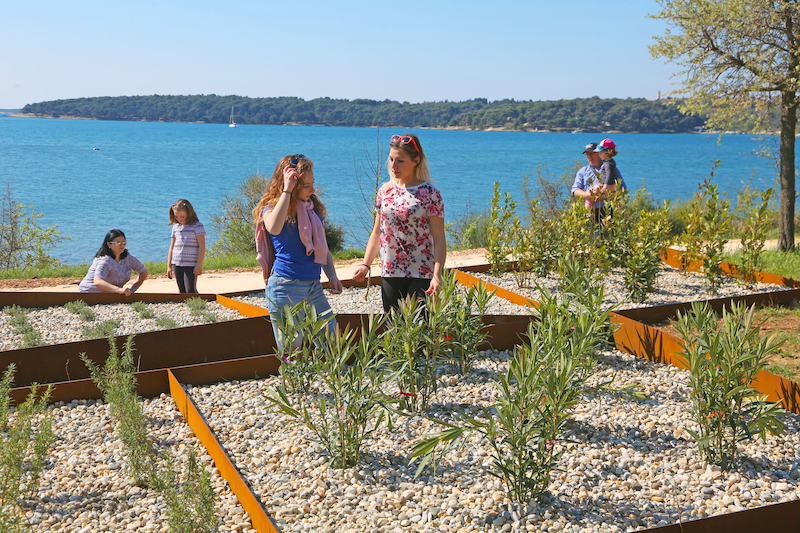
Vižula’s ancient history is reflected in its ancient garden, which is located in the south-western part of the peninsula, next to the former villa rustica. Like an open-air museum, this ancient garden with its horticultural layout, scents and colours gives an insight into the former splendour of the wealthy Roman villa at Vižula.
It is known that horticulture experienced significant development in the Roman Empire. At that time, it was extremely important to have useful plants in the garden, which also had to look good in order to reflect the wealth of the owners. Much attention was given to garden maintenance, especially perfecting the technique of trimming and creating geometric shapes. It was very important to achieve a perfect harmony between the garden and residential buildings, and Roman gardens – as we know from history – were adorned with precious items that also gave the impression of luxury.
Roman gardens usually featured rosemary, which was widely used in pharmacy, cuisine and cosmetics, and laurel, which was awarded to poets and victors in the Olympic Games and wars, and was also placed above the door of patients’ rooms to keep away evil spirits and death. Myrtle was also an important plant in Roman gardens, as it was devoted to Venus, the goddess of love and fertility. The rose was also associated with Venus in Roman times, and legend has it that a white rose turned red when Venus pricked herself on its thorn while hurrying to meet Adonis. Fragrant plants were used to make perfumed water and aromatic massage oils, while herbs were used in cooking.
The ancient garden at Vižula features exclusively those plants that Romans had in their gardens and parks: olive trees (Olea europaea), grape vines (Vitis vinifera), boxwood (Buxus sempervirens), myrtle (Myrtus communis), laurel (Laurus nobilis), thyme (Thymus vulgaris), marigold (Calendula officinalis), oregano (Origanum vulgare), oleander (Nerium oleander), lavender (Lavandula stoechas), rosemary (Rosmarinus officinalis), shrubby everlasting (Helichrysum stoechas), and roses (Rosa div. sp.). Take a break in the shade of an almond tree (Prunus amygdalus) and admire the sight of the pomegranate tree (Punica granatum) and its wonderful fruit that symbolises wealth.
BURLE NECROPOLIS
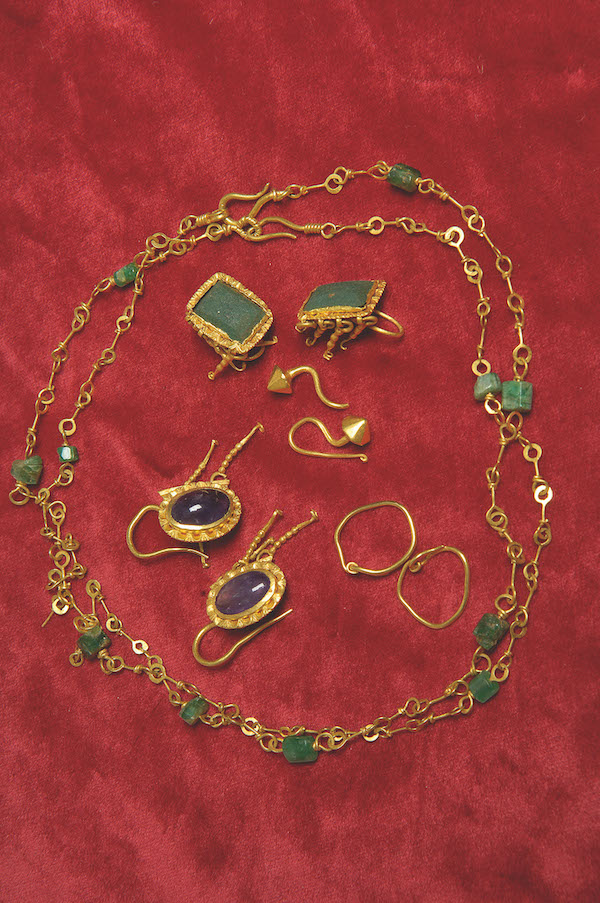
The wealth and splendour of life at Vižula in the past can be seen from the archaeological finds discovered at Burle necropolis located on the isthmus of the same name. This area in the north-eastern part of the mainland was first a necropolis and later a cemetery. A spacious imperial and late antiquity necropolis was found here, which in the north-east was surrounded by a cemetery wall similar to the present ones. The south-eastern and north-western parts of the Medulin necropolis, with the oldest incineration burials of villa residents dating back to the period of Caesar and Augustus, today lie submerged at the bottom of Medulin harbour in Burle Cove. Archaeological research conducted in several stages between 1979 and 2000 and again in 2015 investigated 332 tombs – 60 graves (1st – 6th century) and 272 urn and skeleton burials. It also revealed two lead sarcophagi in walled tombs.
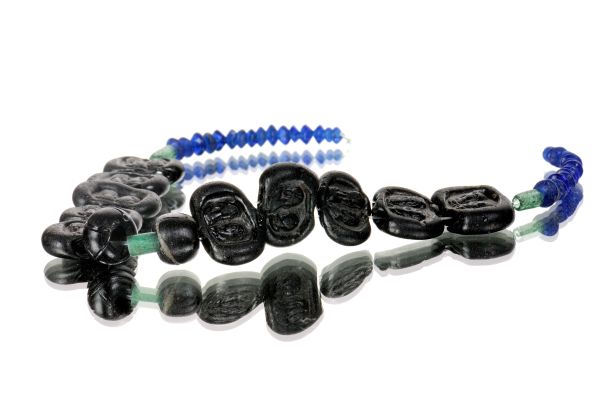
This is the site where the inhabitants of Vižula were buried in the period from the 1st to the 6th century – rich and poor, slaves and freedmen. In her notes, Dr Vesna Girardi Jurkić has pointed out that the discovered gravestones reveal that: ‘a woman named Marcia raised a gravestone slab dedicated to the Mani, the Roman gods of the house, for her beloved husband Aeliodorus, with whom she had lived for eight years, and to her beloved son Valerius Firmin. Another resident of Vižula was a slave named Sabinus, the servant of coloni from Pula, who raised a gravestone to his beloved wife Claudia Pusilla’.
The finds discovered in the lead sarcophagi are particularly interesting and important, attesting to the wealth and importance of the deceased. The sarcophagus of the man contained distinctive sets of glass bottles with the monogram V. D. and palm branches on the bottom of the bottle. In the other lead sarcophagus, there was the skeleton of a woman and also a gold necklace with emeralds and gold earrings with amethysts. Items such as an amber ring (with the image of Heracles), gold earrings, a gemstone with the image of the god Glaucius and a scorpion, ceramic and glass wine chalices, as well as cups and lamps, show that the residents of Vižula were wealthy Romans who lived in luxury. They imported precious items from faraway lands to prove their high economic and political status, according to Dr Vesna Girardi Jurkić in her notes on Vižula.






